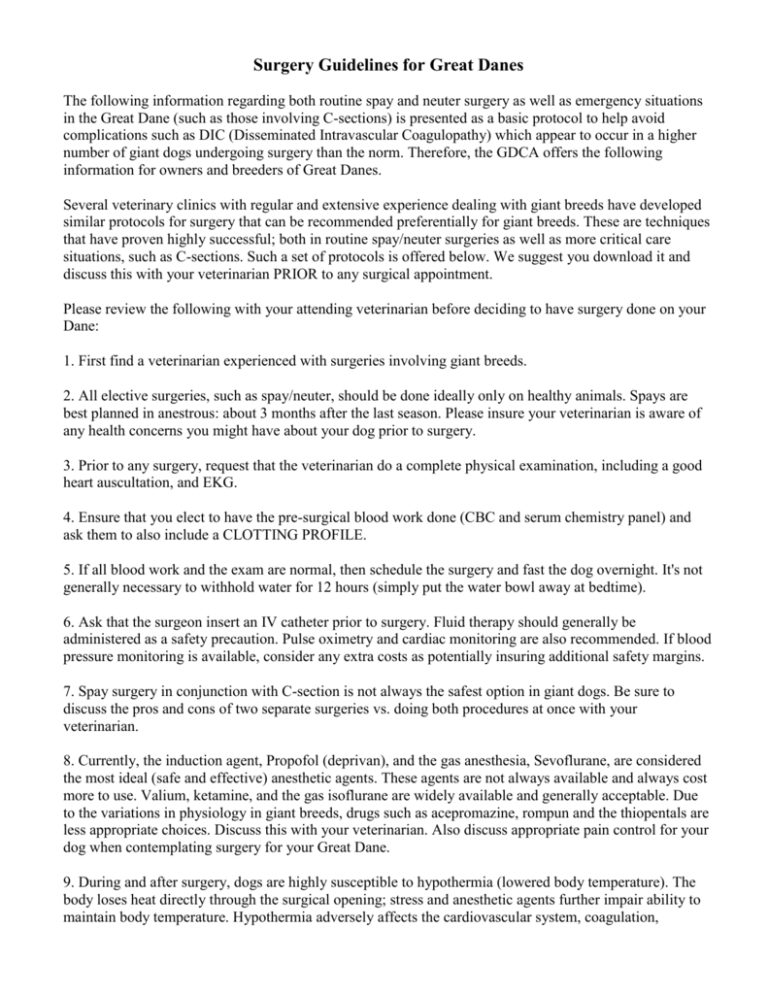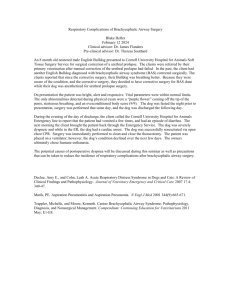File
advertisement

Surgery Guidelines for Great Danes The following information regarding both routine spay and neuter surgery as well as emergency situations in the Great Dane (such as those involving C-sections) is presented as a basic protocol to help avoid complications such as DIC (Disseminated Intravascular Coagulopathy) which appear to occur in a higher number of giant dogs undergoing surgery than the norm. Therefore, the GDCA offers the following information for owners and breeders of Great Danes. Several veterinary clinics with regular and extensive experience dealing with giant breeds have developed similar protocols for surgery that can be recommended preferentially for giant breeds. These are techniques that have proven highly successful; both in routine spay/neuter surgeries as well as more critical care situations, such as C-sections. Such a set of protocols is offered below. We suggest you download it and discuss this with your veterinarian PRIOR to any surgical appointment. Please review the following with your attending veterinarian before deciding to have surgery done on your Dane: 1. First find a veterinarian experienced with surgeries involving giant breeds. 2. All elective surgeries, such as spay/neuter, should be done ideally only on healthy animals. Spays are best planned in anestrous: about 3 months after the last season. Please insure your veterinarian is aware of any health concerns you might have about your dog prior to surgery. 3. Prior to any surgery, request that the veterinarian do a complete physical examination, including a good heart auscultation, and EKG. 4. Ensure that you elect to have the pre-surgical blood work done (CBC and serum chemistry panel) and ask them to also include a CLOTTING PROFILE. 5. If all blood work and the exam are normal, then schedule the surgery and fast the dog overnight. It's not generally necessary to withhold water for 12 hours (simply put the water bowl away at bedtime). 6. Ask that the surgeon insert an IV catheter prior to surgery. Fluid therapy should generally be administered as a safety precaution. Pulse oximetry and cardiac monitoring are also recommended. If blood pressure monitoring is available, consider any extra costs as potentially insuring additional safety margins. 7. Spay surgery in conjunction with C-section is not always the safest option in giant dogs. Be sure to discuss the pros and cons of two separate surgeries vs. doing both procedures at once with your veterinarian. 8. Currently, the induction agent, Propofol (deprivan), and the gas anesthesia, Sevoflurane, are considered the most ideal (safe and effective) anesthetic agents. These agents are not always available and always cost more to use. Valium, ketamine, and the gas isoflurane are widely available and generally acceptable. Due to the variations in physiology in giant breeds, drugs such as acepromazine, rompun and the thiopentals are less appropriate choices. Discuss this with your veterinarian. Also discuss appropriate pain control for your dog when contemplating surgery for your Great Dane. 9. During and after surgery, dogs are highly susceptible to hypothermia (lowered body temperature). The body loses heat directly through the surgical opening; stress and anesthetic agents further impair ability to maintain body temperature. Hypothermia adversely affects the cardiovascular system, coagulation, anesthesia recovery time and increases the risk of wound infection. Preventive measures, including warming of IV fluids, placing the dog on a heated pad (circulating water heating pad or other heating pad set on “low”) and covering the body and extremities with warmed blankets, towels, bubble wrap, or other protective coverings post-surgery are vital in conserving body heat. Temperature monitoring, either via electronic device or rectal thermometer, should be done during surgery and periodically throughout recovery. Prepared by the Health and Welfare committee of the Great Dane Club of America. Written by Sue Cates, RVT and reviewed by LeAnn Lake-Heidke, DVM. Permission to reprint as submitted for educational purposes is given. My Editorial Comments: YOU ARE YOUR PET'S ONLY ADVOCATE There are two issues you need to discuss before doing surgery on your large/giant breed. 1) keeping the dog warm when coming out of the surgery 2) supporting the head and neck during surgery and aftercare. It is crucial that you make sure you have a meeting ahead of time with the vet and staff that will be doing the surgery and handling the after care of your dog. In a survey taken of over 385 Great Dane owners/breeders, 30% of them had lost a dog to spay or neuter surgery. There are precautions you MUST take ahead of time, one being not to spay when bitches are in estrus (see above) or if you have a male in a house full of females in season. Wait until they are all out of season and he is no longer stressed. Yes, they can die in surgery or recovery if they are in the cycle of estrus (season) but they can also expire due to a drop in body temperature causing bleed out. If they get cold coming out of anesthesia and recovery and their body temp drops it can cause them to bleed to death internally, and they are gone before you even know they are bleeding. This is because on a very large dog, the "mass" of the dog is often greater than the area or body surface of the dog, causing them difficulty in keeping hot or cool. If after the surgery they carry your dog to recovery and lay them on a cold concrete floor, it can be a death warrant. They MUST keep the dog on a warm floor - with ample bedding under the dog, and keep the dog covered up with a comforter or blanket as well during the recovery process - usually the first 24 hours is the most crucial.....it is the drop in body heat that causes bleedout internally. I mean make them understand THIS IS REQUIRED from you..and you supply the bed and blanket if you have to, and put it in writing and hand it to the vet as you drop off the dog. It's your dog, you pay the bills, be an advocate for your pet. The second critical issues is for you to tell your vet and staff in writing and verbally"DO NOT ALLOW YOUR DOG'S NECK AND HEAD DANGLE OFF THE OPERATING TABLE DURING SURGERY AND YOU WANT IT SUPPORTED ON EITHER SIDE WITH TOWELS OR A SURGICAL TROUGH". I would ask to talk to the helper that will be carrying the dog back to recovery as well. Make sure every one knows that you want the head and neck of this dog supported at all times, while under anesthesia and during surgery and transport to recovery. I can't tell you the number of dogs that end up with slip disc's or diagnosed with wobblers syndrome right after surgery. This is because the dogs are limp under anesthesia and then not supported properly during surgery or movement to recovery and it causes misalignment of the spine!! Either of these problems wobblers or discs..usually means euthanasia, they are not repairable so you must step up to the plate and be the voice for your pet.









